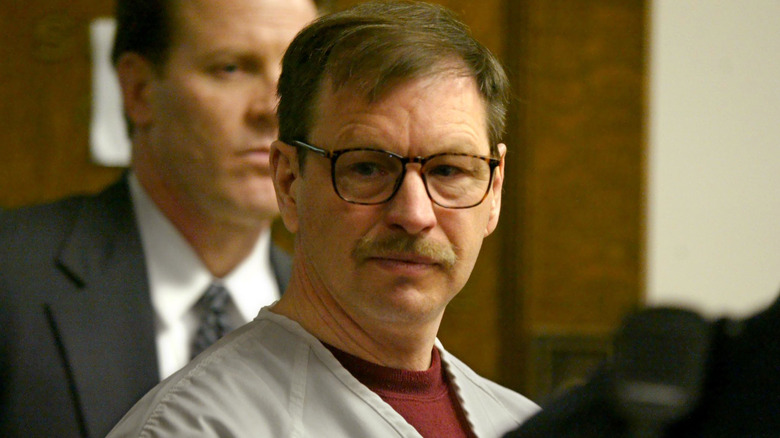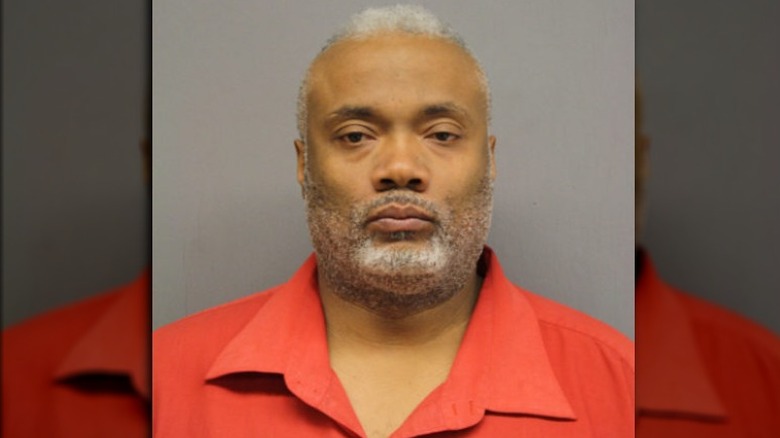The Chicago Strangler Case Is More Messed Up Than You Know
Chicago does not have a reputation for being the safest city in the United States, so much so that it has earned the nickname Chiraq. Murders are a far too common aspect of living in any big city, but according to the Chicago Tribune, Chicago plays host to a disproportionate number, only a fraction of which are genuinely investigated or solved.
Most murders are isolated crimes of passion or done during the commission of other crimes. The case of the Chicago Strangler, a potential serial killer operating in the city for two decades, is far different. Since 2001, at least 55 women (and counting) have lost their lives at the hands of the Chicago Strangler, whom the police have denied even exists. The alleged serial killer's methods are brutal, cold, and repetitive, practically a calling card at this point. If anything, by his apparent indifference to capture, he is almost mocking authorities.
Still, the police swear they see no connections, and too few in the communities affected will admit to having seen anything. How can you combat a monster you won't accept is there?
Two victims in two days
In 2007, the murders of two women in 48 hours, within a few miles of one another, awakened many to the possibility that there might be a serial killer operating in Chicago, according to A&E. They were far from the first women to allegedly fall to the Chicago Strangler, who is suspected to have been operating since 2001. Still, they made the morbid conclusion difficult to ignore.
The first found, Theresa Bunn, had been missing less than a day when she was discovered strangled, stripped, and stuffed in a dumpster. Her body had been doused in accelerant and set on fire. Theresa was eight months pregnant. The next was Hazel Lewis, discovered when the firefighters put out the flames in the garbage can into which she had been shoved. The police hadn't even identified Bunn at this point. Investigators assumed that, given their proximity and the near-identical methods, someone had it in for these women. They set out to find some connection, some person or place, that the two had in common and came up empty.
Both murders remain unsolved, but they were only the beginning of the story of the Chicago Strangler. In 2018, the Chicago Tribune quoted Kaethe Morris Hoffer, executive director of the Chicago Alliance Against Sexual Exploitation, saying, "It is ... upsetting to realize how, if you spread out over a long period of time, how inured people are to the murdering of women, particularly marginalized women."
The Chicago Strangler's victim profile
The Chicago Strangler's victims are, without exception, women, killed on Chicago's South and West sides in the last 20 years, according to WBEZ.
Strangulation is a personal way to kill someone, which led the police to suspect intimate partners when encountering women killed in this way. However, when you are dealing with 55 (or maybe as many as 75) women, all murdered in similar, ghastly ways, all their bodies disposed of with disrespect and in public, that theory must go out the window.
Three-quarters of the Strangler's victims are Black. The Chicago Tribune reported that 47 had some history of sex work. He (given the nature of these crimes, it is very likely the killer is a man) knows that the disappearances of Black sex workers will not be noticed as quickly as other demographics. That gave him all the time he needed to dispose of the victims in alleys, snowbanks, or dumpsters.
The Murder Accountability Project says the Chicago Strangler is real
The Murder Accountability Project is a nonprofit organization founded by Thomas Hargrove, a former journalist who uses an algorithm to analyze uncleared homicide cases in cities to find patterns. Hargrove explained to WBEZ that the algorithm works by looking at murder records and grouping them into similarities between victims (age, gender, weapon, location) and then finding clusters of unsolved cases. These can signal the presence of a serial killer. Women are statistically the most likely victims of serial killers, so the algorithm focuses on them in particular.
Chicago Reader reported that Hargrove used his algorithm to great success in Gary, Indiana. His Murder Accountability Project assisted in the 2010 capture of Gary Ridgway, the Green River Killer (pictured) — who also focused his murders on sex workers. The police had not seen the pattern in the 70-some murders before Hargrove stepped in. CBS Chicago quoted him as saying, "We had total radio silence from those guys."
When the algorithm looked at the uncleared homicide cases in Chicago, it let off a red alert. The Murder Accountability Project maintains that a serial killer is operating in Chicago. Hargrove said, "We know this is a series. We have no doubt."
The Chicago Strangler's M.O.
The Chicago Tribune reported that, with few exceptions, the women were killed by strangulation, either by bare hands or with a ligature like a belt, rope, or the women's bras. Some were suffocated via plastic bags placed over their heads. Most were at least partially undressed, if not completely naked, and many of them showed some signs of sexual assault.
The bodies were found in semi-public places, like back alleys, empty lots, snowbanks, or dumpsters — places where someone should have seen them placed and set on fire. The Chicago Strangler barely attempts to hide his crimes, and that's if he's not outright gloating about them, knowing that the police do not take him seriously. The murders show a consistent enough modus operandi that it's surprising the police haven't made the connections.
Beyond the similarities in the deaths and victims, there is no established profile for the Chicago Strangler. Is he college-educated? White? Does he believe that he is on a holy mission to kill sex workers, or is he venting his sexual inadequacy like other, known serial killers? Any of this information could identify him, but there is nothing but the results of his crimes.
According to Chicago Reader, the killings stopped in 2014, only to pick up again in 2017, which signified to Thomas Hargrove that the killer had been incarcerated and released, immediately picking back up his murder spree. The police, however, just saw typical city violence.
Where the bodies are found
To A&E, Thomas Hargrove noted, "There is one very odd pattern in the map: There is a very linear array of body recovery sites on the Chicago Near South Side, which forms an almost perfect north-south line." This is pretty much the same line as the Chicago Green Line elevated train. Hargrove shared this information with the Chicago police, though neither the Murder Accountability Project nor the CPD were willing to state outright that the killer was using mass transit to find and slay his victims. It would be impossible to move the bodies on a train, but surely there are usable data points that have yet to be explored.
WBEZ reported that the largest cluster in the South Side is linear, north to south, suggesting that the killer found the woman along a certain route. If this were the case, the killer would also likely have a vehicle to transport the bodies — far more manageable than on the train.
Where the bodies are found are unsurprisingly not the safest corners of Chicago, so much so that people who live there don't use the alleys where the bodies have been discovered. One resident, Becky DeaKyne, told the Chicago Tribune, "I don't drive in them. I don't walk in them. It's not safe. It's not smart. ... Everybody is afraid to go out, so there is nobody to scream help to."
Police denials
The Chicago Police Department put out a statement to Vice reading: "[T]here is absolutely no information to suggest this is the work of an active serial killer. To conclude otherwise, without detailed case information known by detectives, would be hyperbolic and careless."
Yes, these women are dead, but women are murdered every day, rarely provoking suspicions of a serial killer. Intimate partner violence is far from unusual, and if one is going to kill a sex worker, strangulation after sexual assault is, sadly, hardly an unheard-of method. As noted by Chicago Reader, plenty of men are being shot in Chicago — no one is presupposing that one person is killing all of them.
Different precincts are not working together on these cases — or, it seems, most. Without that pool of resources, it falls to the public to draw the lines. The Chicago Tribune reported that a task force to respond to the city's many murders of women was formed in the late 1990s, but it was disbanded soon after despite the killings continuing unabated. (To their credit, they did convict several unrelated subjects, including serial killers. Just not the Chicago Strangler.)
Why hasn't the Chicago Strangler been caught?
Given the long-running nature of the killings, it seems perplexing that little headway has been made in the cases. However, it is precisely because the killings have gone on so long that complicates it.
Compared to any similarly sized city in America, Chicago has a shockingly low clearance rate for homicides. Thomas Hargrove said to Chicago Reader, "Chicago spiraled out of control when it started solving only a third of its murders. Murder begets murder." Though it would only be speculation to wonder if the killer chose Chicago for this deficit, it must be appealing to know that his chances of being caught are comparatively small. Spending two decades operating in the city, hearing the police publicly doubt that he even exists, could embolden a killer. If he were going to be caught, wouldn't he have been long ago?
According to Medill Reports, backlogs in the Illinois State Forensic Labs have delayed the processing of some evidence as much as 30 years, causing miscommunications when it comes to interdepartmental collaboration. Some improvements in the late 2010s helped them catch up on their backlogs, but they don't have the funding or staff necessary to clear them all, which could only be to a serial killer's benefit.
Is racism to blame?
Racism may play a factor in the Chicago Strangler's longevity. Most of the victims are Black women, a demographic whom the police have often been accused of not prioritizing. To WGN 9, Roosevelt University journalism professor John Fountain said, "I am convinced that if there were 51 dogs killed in the city of Chicago, people would be up in arms but we aren't."
Many feel that the deaths of more than 50 primarily Black women, many of whom were sex workers, have been largely met by a shrug from the police and media, to the victims' families' horror, before the Murder Accountability Project noted the pattern. WBEZ reported that Chicago has a poor rate of murders being solved for Black residents: less than 22%, compared to 47% for white residents, during a 19-month period.
Chicago Reader noted that the real serial killer here might not be a man but the indifference toward Black lives and the economic disparity of the city. People care so little about these groups that a serial killer could act with impunity, or there are so many unsolved cases in these neighborhoods that it is easy enough to imagine a pattern.
Victims' families silenced
The voices of the victims' families are often silenced. In part, this is because they are met with cruelty when mourning a mother, sister, or daughter who had turned to sex work or drugs, as though brutal murder is a natural consequence.
The silencing is also more insidious and institutional. In some of these neighborhoods, it is generationally known that the police are not who you go to for help. If you call the police, even about the corpse in the dumpster, you may be asking for trouble. According to Dawn Valenti, a victims' advocate and crisis responder, speaking to A&E, "People are scared, and people don't want to talk. They want to retaliate."
Involving the police can also interfere with the grieving families receiving what small help a life insurance policy can provide. If the police label a murder as a gang-related killing — even if the victim had nothing to do with any gangs — the family could end up with nothing.
In some cases, the families are eager to speak to the police, but the police do not feel the same. They will not interview anyone, just note that it happened and go about their shifts. The son of one of the victims told the Chicago Tribune, "They just picked the body up and left. We (are) just looked over."
The Chicago police finally investigate
Eventually, owing to the Murder Accountability Project allowing the victims' families' voices to be amplified, the Chicago Police Department agreed to assign officers to solve these murders.
Four detectives in total, Chicago Reader reported, teamed up with agents from the FBI's Violent Crimes Task Force. They reviewed what evidence they had, including DNA taken from the bodies. According to Medill Reports, they were able to identify DNA belonging to 21 different men, none of whom were in the system. Thomas Hargrove said, "DNA has not been the magic bullet that we all had hoped for, especially the Chicago police." It is strange enough that a case of strangulation would turn up so little DNA evidence that Hargrove suggested that the killer was intelligent or practiced enough to leave little behind. To him, the absence of evidence is evidence. What is certain is that the murderer or murderers of these women have not been caught.
The police concluded again that none of these cases were connected. They feel, for example, that some murders were likely acts of domestic violence ending in back-alley dumpster fires, not cases of women being killed because they were in high-risk situations.
Arthur Hilliard, the Chicago Strangler?
According to A&E, in January 2020, the Chicago Police Department arrested Arthur Hilliard for the murder of Diamond Turner, a presumed victim of the Chicago Strangler. DNA evidence tied him to the 21-year-old woman, whose body was found in a garbage can behind Hillard's apartment in March 2017. She had experienced blunt-force trauma before being asphyxiated. Thomas Hargrove noted, "Any arrest they make among these 51 strangulations should be — and I'm sure will be — aggressively reviewed for the possibility that they are in fact linked to other killings."
Chicago Reader reported the abundance of evidence: Hilliard had been in a sexual relationship with Turner, witnesses saw him cleaning bloodstains that led from his bedroom to his back door, and Hilliard disposed of his mattress soon after. As such, after identifying him as Turner's possible murderer and collecting the evidence, it is baffling that the police waited three years to get around to arresting him for her murder. While people suspected a serial killer was prowling the city, Hilliard was left free to roam. The reason? It took that long to process the DNA evidence from the scene.
Chief of Detectives Brendan Deenihan noted no links between Hilliard and any of the other Chicago Strangler slayings.
What is the better scenario? One killer or many?
Medill Reports claimed that the Chicago Police Department received confidential information from witnesses that there are two to three serial killers, all operating under the presumed umbrella of the Chicago Strangler. In a forum with his district, Chicago Reader noted, U.S. congressman Bobby Rush said, "We all must continue to think that there is a possible serial killer or killers that's living among us."
Instead of one twisted, soulless monster who gets off on strangling and burning women, we theoretically have as many as 50-some killers who adopted a similar M.O., with only one arrest. Is it more reassuring that there are individual murderers by droves in Chicago or that there are only one or two guilty of all of them?
Thomas Hargrove said, "These 51 women were not killed by 51 separate men. Many of these [women], probably most of these were killed by men who have killed before." No matter how terrifying the thought of a serial killer is, if there is only one culprit — or only a few — they can be arrested, and the Chicago Strangler's next victim can be saved. To CBS Chicago, Hargrove said, "Women in Chicago should be warned that they're being targeted. That sex workers, women who habitually use illegal drugs, there's a target on them."












